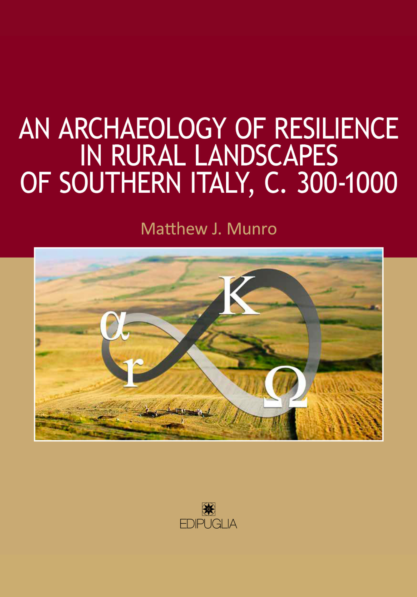
È appena stato pubblicato il quarto volume della collana di studi storico-archeologici “Themata”, dal titolo “An Archaeology of Resilience in Rural Landscapes of Southern Italy, c. 300-1000”, scritto da Matthew J. Munro.
Questo volume nasce da una tesi di dottorato che riflette sul ruolo della resilienza nel collasso e nella rigenerazione delle società umane tra la tarda Antichità e l’alto Medioevo. L’approccio adottato applica il metamodello della panarchia e i principi della scienza della complessità per comprendere il ruolo della resilienza negli sviluppi del paesaggio dell’Italia meridionale. Questa regione rappresenta un luogo ideale per sviluppare e testare questo modello: i dati archeologici, storici e ambientali sono ben documentati e dimostrano sia interruzioni che continuità nei sistemi di interazione uomo-ambiente tra il mondo romano e quello medievale. Una volta presentate le evidenze paesaggistiche e costruita la panarchia, quest’ultima diventa uno strumento potente per supportare l’analisi del paesaggio. Il caso di studio della Valle del Basentello presentato in questo volume è solo un esempio di come il “pensiero sulla resilienza” possa mettere alla prova vecchie ipotesi e porre nuove domande su questo periodo di trasformazione, offrendo ai ricercatori una prospettiva innovativa sul collasso e sulla rigenerazione delle società.
L’opera è acquistabile dal sito web di EDIPUGLIA, in versione cartacea e in PDF.
INDICE
Munro’s resilience
by Paul Arthur
Acknowledgements
List of Figures
List of Tables
A Word About Spelling and Notations
I. PROBLEMATIZING AND ORIENTING RESILIENCE
1. Problematizing Resilience in Southern Italy
2. Considering a Landscape Perspective
3. The Southern Italian Landscape
4. The Complexity of Landscape and Collapse
5. Redefining Resilience
6. The Path Forward
PART I
FRAMING THE PROBLEM
II. COLLAPSE, REGENERATION, RESILIENCE, AND SCALE: THE PRECONDITIONS FOR A MODEL
1. Theorizing Collapse
2. Theorizing Regeneration
3. Deconstructing Resilience
4. Temporal Perspectives
5. The Preconditions for a Model
III. THE RESILIENCE FRAMEWORK
1. The Adaptive Cycle
2. Scaling a System: Panarchy
3. Characterizing Social Resilience
4. Constituting a Landscape Approach to Resilience
5. A Heuristic Framework for Investigating the Role of Resilience
PART II
BUILDING THE MODEL
IV. THE COMPLEXITY OF THE SOUTHERN ITALIAN LANDSCAPE
1. Establishing the Initial Conditions: The Rural Landscape of Late Roman Southern Italy
2. The Ecohistorical Regimes of the Southern Italian Landscape
3. The Value of Ecohistorical Regimes
V. FRAMING THE PANARCHY
1. Adaptive Cycles: The Political System
2. Adaptive Cycles: The Economic System
3. Adaptive Cycles: The Urban System
4. Visualizing Panarchy
VI. SHOCKS AND STRESSORS I: CLIMATE AND ENVIRONMENT
1. Climate History
2. Natural Dynamics and Environmental Disasters
PART III
LANDSCAPE ANALYSIS
VII. SHOCKS AND STRESSORS II: CONFLICT, DISEASE, AND FOOD SHORTAGES
1. Conflict in the Landscape
2. Disease and Food Shortages
3. Buffeting the Panarchy
VIII. A CASE STUDY IN RESILIENCE I: DATA FROM THE BASENTELLO VALLEY C. 300-1000
1. Notes on the Data
2. The Basentello Valley in the Roman Period
3. The Basentello Valley in Late Antiquity
4. The Basentello Valley in the Sixth Century
5. The Basentello Valley in the Early Middle Ages
6. Landscape Dynamics in the Basentello Valley: A Balance Sheet and Summary
IX. A CASE STUDY IN RESILIENCE II: INTERPRETING RESILIENCE IN THE BASENTELLO VALLEY
AND BEYOND, C. 300-1000
1. Connectedness, Potential, and Capacities for Resilience
2. Panarchic Analysis
3. The Strategies for Resilience and their Role in the Basentello Valley
4. Looking Beyond: The Role of Resilience in Rural Southern Italy from Late Antiquity to the Early Middle Ages
PART IV
THE ROLE OF RESILIENCE
X. Archaeology, Resilience, Landscape, and Complexity
1. In Conclusion: Archaeology, Resilience, Landscape, and Complexity in Southern Italy
2. Insights from Collapse, Regeneration, and the Presumption of Resilience
3. Insights from the Resilience Framework
4. Insights from Building the Model
5. Insights from Conducting Panarchic Analysis at the Landscape Scale
6. The Future
APPENDIX A. Bibliographic Essay
APPENDIX B. Tables for the Survey Zone
REFERENCES CITED

